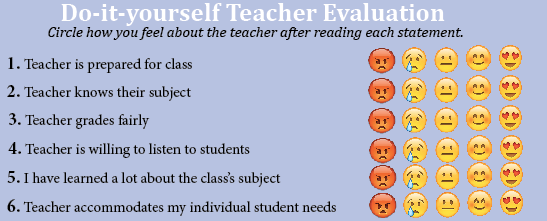Let students evaluate teachers

Student evaluation of teachers should be a part of the school’s teacher evaluation process.
Under the current teacher evaluation system, which ETHS adopted in 2013, teachers are evaluated only through professional practice, or the department chair observing a teacher during classes.
Bill Farmer, head of the Teacher’s Council, says professional practice will only make up 70 percent of the system starting next year. The other 30 percent will consist of grades, test scores and other indications of student growth.
Tenured teachers (teachers who have been employed for four or more years), are evaluated every two years, and non-tenured teachers, are evaluated every year, receive grades of “excellent,” “proficient,” “needs improvement,” or “unsatisfactory.” Two grades of “unsatisfactory” within 36 months allow for a teacher to be fired.
The Evanston Roundtable’s recently reported about the adopting of this policy, and stated that Russell Fillmore-Brady, the student representative at the time, brought up student evaluation of teachers, but received a mostly negative response.
Opponents argue that students will rate teachers they like higher than teachers who are harsh graders or whom they just don’t like.
Having had many different teachers and many different experiences with those teachers, students know what defines a teacher as adequate or inadequate.
A possible model that could be used for student evaluation is from the Tripod Project, which researches and tests teacher evaluation surveys for students. One such survey could be used here, as it is currently used in cities such as Denver, Pittsburgh, and Memphis. Student evaluation would obviously not be the main factor for evaluating teachers. But students, who observe the teacher every school day, should play a part.
Your donation will support the student journalists of the Evanstonian. We are planning a big trip to the Journalism Educators Association conference in Philadelphia in November 2023, and any support will go towards making that trip a reality. Contributions will appear as a charge from SNOSite. Donations are NOT tax-deductible.











